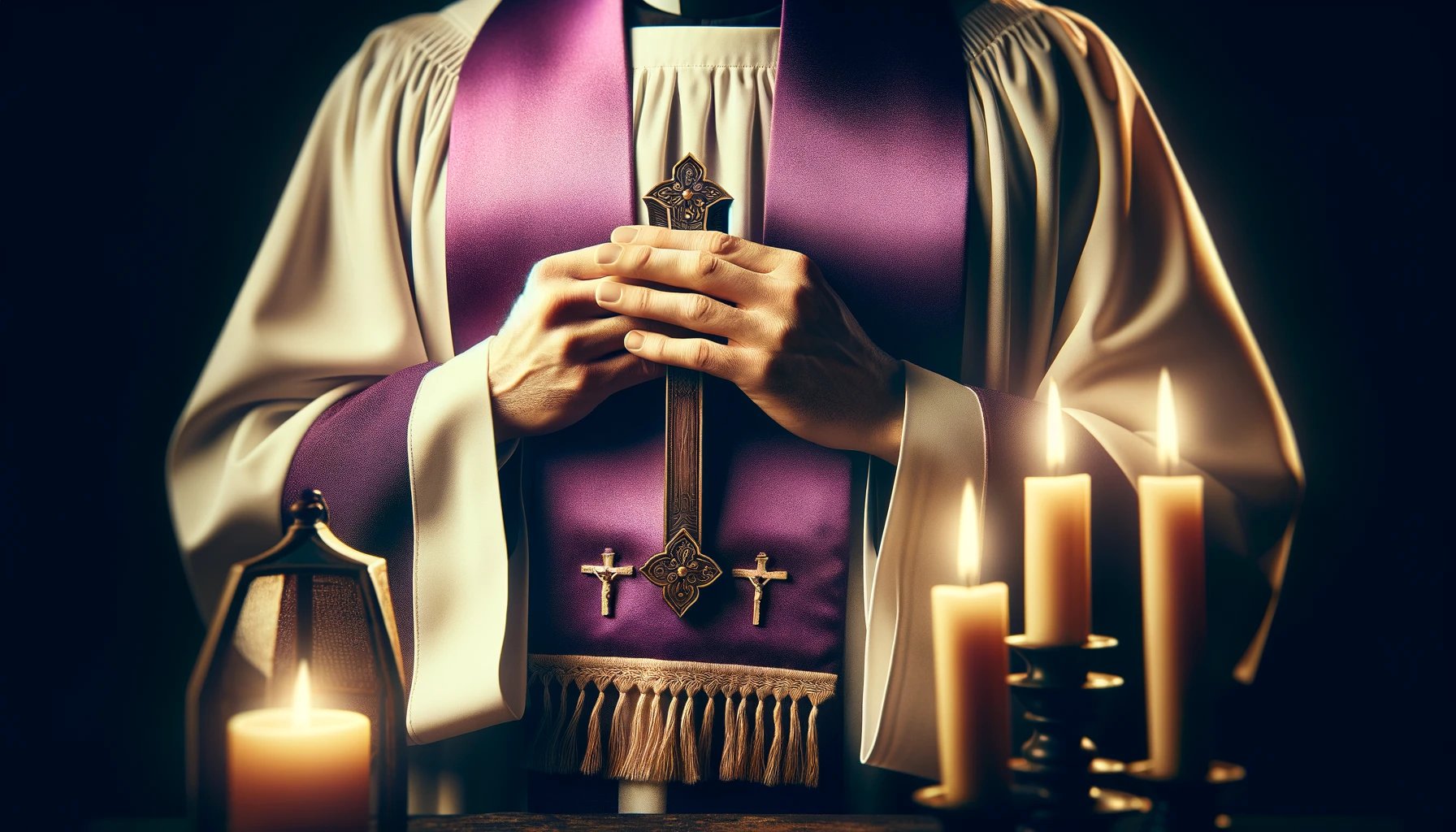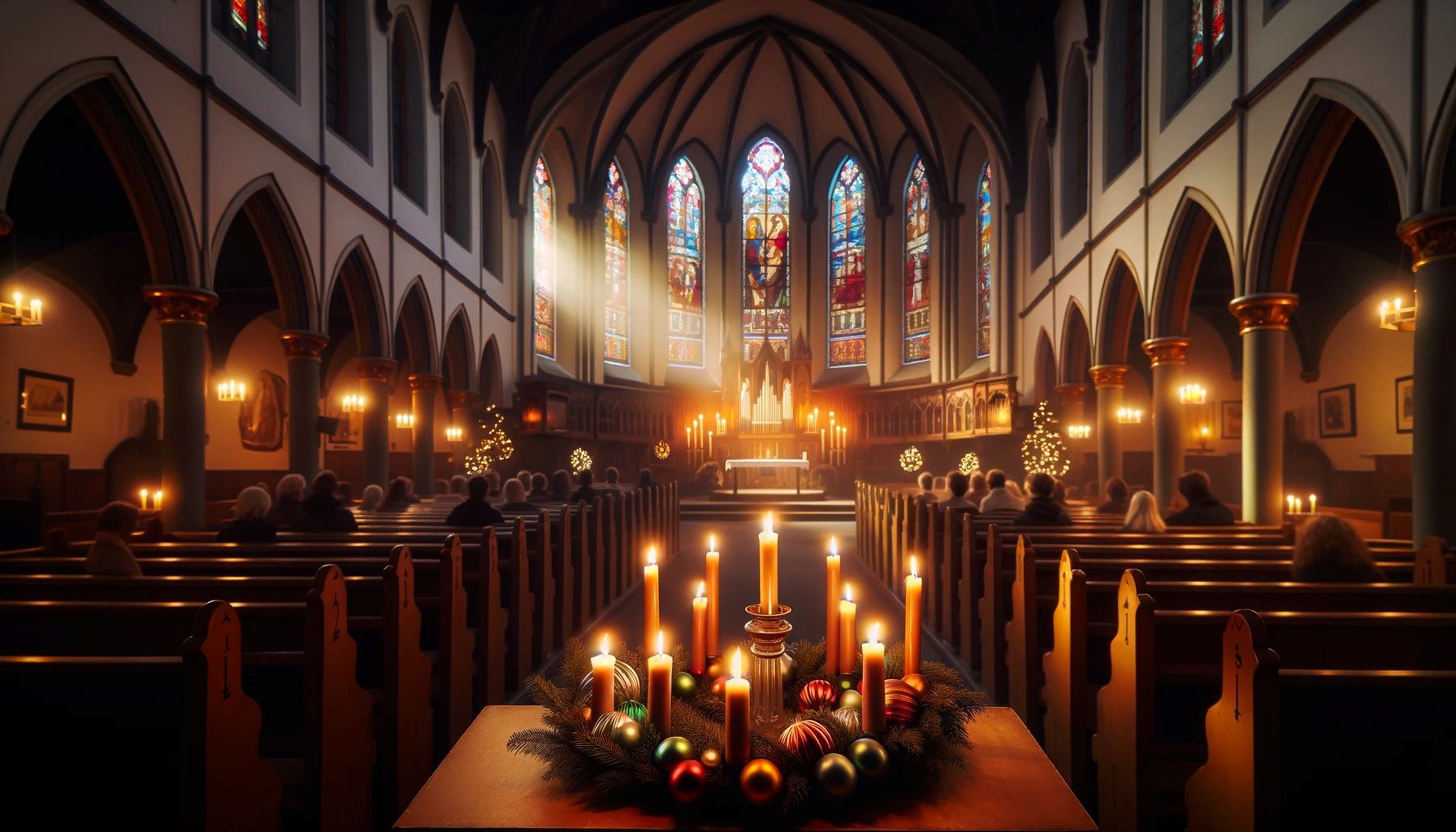Home>Special Themes>What Is The Liturgical Color For Advent


Special Themes
What Is The Liturgical Color For Advent
Published: February 14, 2024
Ericka Andersen, an editor at Christian.net, expertly merges digital strategy with content creation, focusing on faith and societal issues. Her communication skills enhance the platform's engaging narratives, fostering meaningful dialogue on belief's impact on society.
Discover the significance of the liturgical color for Advent and its special themes. Learn about the traditions and meanings behind this sacred season.
(Many of the links in this article redirect to a specific reviewed product. Your purchase of these products through affiliate links helps to generate commission for Christian.net, at no extra cost. Learn more)
Table of Contents
Introduction
The use of colors in religious ceremonies and observances has a rich history that dates back centuries. In the Christian tradition, the practice of utilizing specific colors during different seasons and celebrations holds deep symbolic significance. These colors, known as liturgical colors, are not merely decorative elements but are imbued with profound meaning and spiritual symbolism.
One of the most significant liturgical seasons in the Christian calendar is Advent. As the faithful prepare for the celebration of the birth of Jesus Christ, the use of specific colors during this period adds a layer of depth and symbolism to the observance. Understanding the significance of these colors enriches the spiritual experience and connects the faithful to the traditions and teachings of the Church.
In this article, we will delve into the history of liturgical colors, explore the meaning of Advent, and uncover the symbolism behind the specific color associated with this sacred season. Additionally, we will touch upon other liturgical colors that are connected to Advent, providing a comprehensive understanding of the visual and symbolic elements that enrich this significant period in the Christian faith.
Read more: What Liturgical Color Is Advent
The History of Liturgical Colors
The use of colors in religious ceremonies can be traced back to ancient times, with evidence of their significance found in various religious traditions around the world. In the Christian tradition, the practice of employing specific colors during different seasons and celebrations has a history that dates back to the early centuries of the Church.
The development of liturgical colors can be linked to the desire to visually enhance the spiritual experience and convey the themes and moods of different liturgical seasons and feasts. Over time, the Church established a system of colors that became associated with specific periods and events in the Christian calendar.
The origins of liturgical colors can be found in the early Christian communities, where the use of colors in worship and religious ceremonies began to take shape. The symbolism and significance of these colors were deeply rooted in the teachings and traditions of the Church, reflecting the theological and spiritual themes of the respective seasons and celebrations.
As the liturgical calendar evolved, the use of specific colors became more standardized, with each color carrying its own symbolic meaning and theological significance. The colors came to represent the various aspects of the Christian faith, including penitence, joy, sacrifice, and the anticipation of significant events such as the birth of Jesus Christ and His resurrection.
The development of liturgical colors also reflected the influence of art and culture on religious practices. The use of vibrant hues and rich fabrics in liturgical vestments and decorations added a visual dimension to the worship experience, creating a sense of reverence and solemnity.
Today, the tradition of liturgical colors continues to be an integral part of Christian worship, serving as a visual reminder of the rich tapestry of the faith and the enduring significance of its sacred seasons and celebrations. The history of liturgical colors is a testament to the enduring power of symbolism and tradition in the practice of the Christian faith, enriching the spiritual journey of believers and connecting them to the timeless heritage of the Church.
The Meaning of Advent
Advent, derived from the Latin word "adventus," meaning "coming" or "arrival," holds profound significance in the Christian faith. It marks the beginning of the liturgical year and is a period of joyful anticipation and spiritual preparation for the celebration of the birth of Jesus Christ. Advent encompasses the four Sundays leading up to Christmas, serving as a time of reflection, hope, and expectation as believers await the arrival of the Messiah.
At its core, Advent embodies the dual nature of the Christian faith – looking back to the humble yet profound birth of Jesus in Bethlehem and looking forward to His promised return in glory. This season invites believers to enter into a spirit of contemplation and readiness, embracing the themes of hope, peace, joy, and love that are central to the Christian message.
The symbolism of Advent is encapsulated in the lighting of the Advent wreath, a cherished tradition in many Christian communities. The wreath, typically adorned with four candles, each representing a week of Advent, serves as a visual reminder of the journey toward the celebration of Christ's birth. The progressive lighting of the candles symbolizes the increasing light and hope that Christ brings into the world, dispelling darkness and illuminating the path of faith.
Moreover, Advent encourages believers to engage in introspection and spiritual preparation, fostering a sense of anticipation and longing for the fulfillment of God's promises. It is a season of repentance and renewal, prompting individuals to examine their hearts and align their lives with the teachings of Christ as they await His coming.
The rich symbolism of Advent extends beyond the individual and encompasses the broader themes of redemption and salvation. It serves as a poignant reminder of the profound love and grace of God, who, in sending His Son into the world, offered humanity the ultimate gift of hope and reconciliation.
In essence, Advent represents a sacred journey – a journey of faith, hope, and expectation. It invites believers to immerse themselves in the timeless narrative of the Nativity, embracing the promise of Emmanuel, "God with us," and anticipating the fulfillment of God's redemptive plan for humanity.
As the faithful embark on this spiritual pilgrimage, the season of Advent becomes a profound expression of the enduring hope and joy that characterize the Christian faith, illuminating the path toward the celebration of the Incarnation and pointing toward the ultimate fulfillment of God's kingdom.
The Liturgical Color for Advent
The liturgical color most commonly associated with Advent is purple. This regal hue holds deep symbolic significance within the context of the Advent season, conveying themes of penitence, preparation, and anticipation. The use of purple in the liturgical observance of Advent serves as a visual representation of the solemn and reflective nature of this period, inviting believers to engage in introspection and spiritual readiness as they prepare to celebrate the birth of Jesus Christ.
The color purple has long been associated with royalty and majesty, reflecting the anticipation of the arrival of the King of Kings during Advent. It conveys a sense of reverence and solemnity, underscoring the significance of the impending celebration of the Incarnation. Moreover, purple is also traditionally linked to penitential seasons within the Christian calendar, signifying a time of repentance, self-examination, and spiritual discipline. This aspect of purple aligns with the preparatory nature of Advent, prompting believers to cultivate a spirit of humility and contrition as they await the coming of Christ.
In addition to its symbolic associations, the use of purple in Advent also serves as a visual contrast to the vibrant and joyful colors often present during the Christmas season. The somber yet rich tones of purple create a distinct atmosphere of anticipation and contemplation, setting the stage for the profound significance of Christ's birth. This intentional shift in color palette underscores the transition from the introspective and preparatory period of Advent to the exuberant celebration of Christmas, marking a seamless progression in the liturgical journey.
The liturgical color of purple during Advent thus encapsulates the essence of this sacred season, embodying the themes of expectation, humility, and spiritual readiness. It serves as a visual reminder of the profound significance of Christ's coming into the world, prompting believers to enter into a spirit of contemplation and anticipation as they prepare to commemorate the Nativity. The use of purple in Advent enriches the worship experience, infusing it with depth and symbolism, and connecting the faithful to the timeless traditions and teachings of the Christian faith.
The Symbolism of the Color Purple
The color purple, deeply embedded in the liturgical observance of Advent, carries profound symbolism that enriches the spiritual significance of this sacred season. As believers engage in the reflective and anticipatory journey of Advent, the use of purple serves as a visual and symbolic anchor, encapsulating the essence of this period of preparation and expectation.
Purple, historically associated with royalty and majesty, conveys a sense of reverence and solemnity, aligning with the anticipation of the arrival of the King of Kings during Advent. This regal hue evokes the image of a royal procession, underscoring the significance of the impending celebration of the Incarnation. It invites believers to approach the Nativity with a spirit of awe and humility, recognizing the divine majesty of the Christ child who entered the world to bring salvation and hope.
Furthermore, the color purple is traditionally linked to penitential seasons within the Christian calendar, signifying a time of repentance, self-examination, and spiritual discipline. This aspect of purple aligns with the preparatory nature of Advent, prompting believers to engage in introspection and self-reflection as they prepare to commemorate the birth of Jesus Christ. It serves as a visual reminder of the call to humility and contrition, inviting individuals to embrace a spirit of repentance and renewal as they await the coming of the Savior.
In addition to its symbolic associations, the use of purple in Advent creates a deliberate contrast to the vibrant and joyful colors often present during the Christmas season. The somber yet rich tones of purple set a contemplative tone, inviting believers to enter into a period of spiritual readiness and anticipation. This intentional shift in color palette underscores the transition from the introspective and preparatory period of Advent to the exuberant celebration of Christmas, marking a seamless progression in the liturgical journey.
The symbolism of the color purple in Advent thus extends beyond its visual appeal, serving as a powerful conduit for the spiritual themes and theological significance of this sacred season. It invites believers to immerse themselves in the timeless narrative of the Nativity, embracing the promise of Emmanuel and anticipating the fulfillment of God's redemptive plan for humanity. The use of purple in Advent enriches the worship experience, infusing it with depth and symbolism, and connecting the faithful to the enduring traditions and teachings of the Christian faith.
Read more: Why Is Blue The Liturgical Color For Advent
Other Liturgical Colors Associated with Advent
While purple is the predominant liturgical color associated with Advent, there are additional hues that hold symbolic significance within the context of this sacred season. One such color is blue, which has been adopted by some Christian denominations as an alternative to purple for Advent. The use of blue during Advent conveys a sense of hope, anticipation, and the expectation of the coming of Christ. This serene and contemplative color evokes the image of the night sky, symbolizing the quiet and profound longing for the fulfillment of God's promises. Blue serves as a visual representation of the hope and anticipation that characterize the Advent season, inviting believers to embrace a spirit of peaceful expectation as they prepare to celebrate the birth of Jesus Christ.
In certain traditions, a third liturgical color associated with Advent is pink or rose. This color is often used on the third Sunday of Advent, known as Gaudete Sunday, which signifies a shift from the penitential tone of the season to a sense of joyful anticipation. The use of pink or rose on Gaudete Sunday serves as a visual marker of the approaching celebration of Christmas, infusing the season with a sense of rejoicing and anticipation of the imminent arrival of the Savior. This brief departure from the traditional purple or blue underscores the themes of joy and anticipation, offering a glimpse of the exuberant celebration that awaits at the culmination of Advent.
The inclusion of blue and pink as alternative liturgical colors associated with Advent reflects the diverse traditions and practices within the Christian faith. While purple remains the primary color symbolizing penitence, preparation, and anticipation, the use of blue and pink offers nuanced expressions of the multifaceted themes woven into the fabric of the Advent season. These additional colors enrich the visual tapestry of Advent, providing depth and diversity in the symbolic representation of the spiritual journey toward the celebration of the Nativity.
Incorporating blue and pink into the liturgical observance of Advent underscores the dynamic nature of the Christian faith, accommodating a spectrum of interpretations and expressions while maintaining the foundational significance of this sacred season. The inclusion of these alternative colors serves as a testament to the richness and diversity of Christian traditions, offering believers a visual and symbolic palette that resonates with the varied spiritual experiences and expressions of hope, anticipation, and joy that define the Advent season.
Conclusion
In conclusion, the use of liturgical colors, particularly the significance of the color purple, enriches the observance of the Advent season in the Christian faith. The history of liturgical colors reflects the enduring tradition of visually enhancing the spiritual experience and conveying the themes and moods of different liturgical seasons and feasts. The symbolism of Advent, with its emphasis on hope, anticipation, and spiritual preparation, underscores the profound significance of this sacred season in the Christian calendar.
The liturgical color of purple during Advent serves as a visual representation of the solemn and reflective nature of this period, inviting believers to engage in introspection and spiritual readiness as they prepare to celebrate the birth of Jesus Christ. The regal hue of purple conveys a sense of reverence and solemnity, aligning with the anticipation of the arrival of the King of Kings during Advent. It also serves as a visual contrast to the vibrant and joyful colors often present during the Christmas season, marking a seamless progression in the liturgical journey.
Furthermore, the inclusion of alternative liturgical colors such as blue and pink offers nuanced expressions of the multifaceted themes woven into the fabric of the Advent season, enriching the visual tapestry of this sacred period. These additional colors provide depth and diversity in the symbolic representation of the spiritual journey toward the celebration of the Nativity, accommodating a spectrum of interpretations and expressions while maintaining the foundational significance of Advent.
As believers immerse themselves in the timeless narrative of the Nativity and anticipate the fulfillment of God's redemptive plan for humanity, the use of liturgical colors becomes a powerful conduit for the spiritual themes and theological significance of the Advent season. It invites individuals to embrace the promise of Emmanuel, "God with us," and to anticipate the ultimate fulfillment of God's kingdom.
In essence, the practice of utilizing specific liturgical colors during Advent serves as a visual and symbolic reminder of the enduring hope and joy that characterize the Christian faith. It connects the faithful to the timeless traditions and teachings of the Church, enriching the worship experience and illuminating the path toward the celebration of the Incarnation.
The use of liturgical colors in the observance of Advent thus transcends mere visual aesthetics, becoming an integral part of the spiritual journey, and a testament to the enduring power of symbolism and tradition in the practice of the Christian faith.














